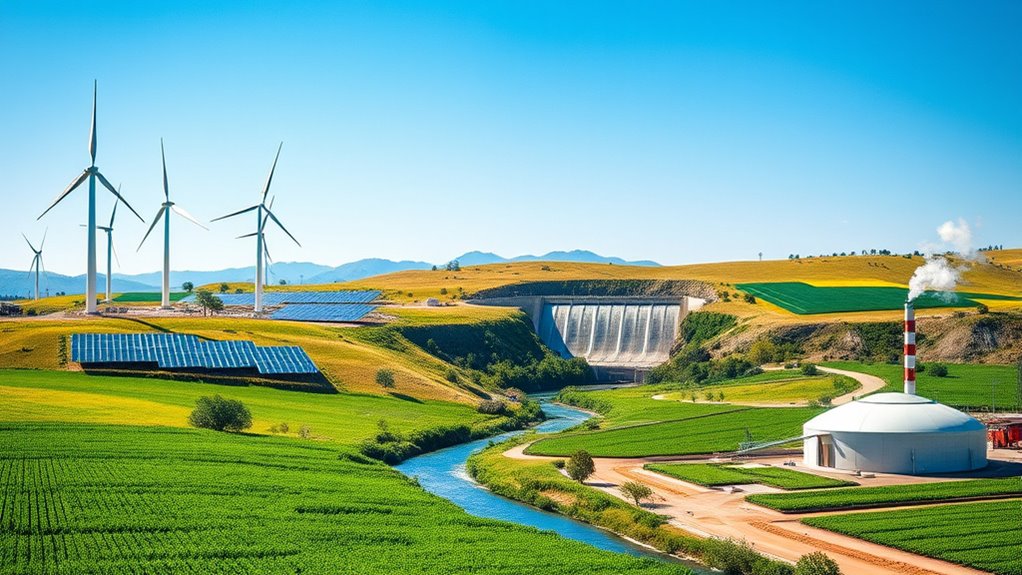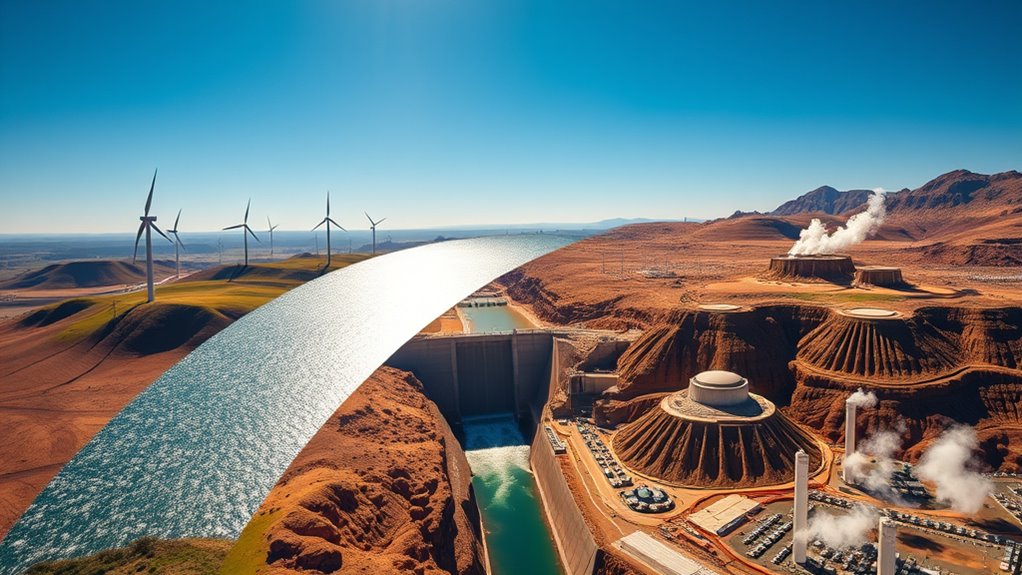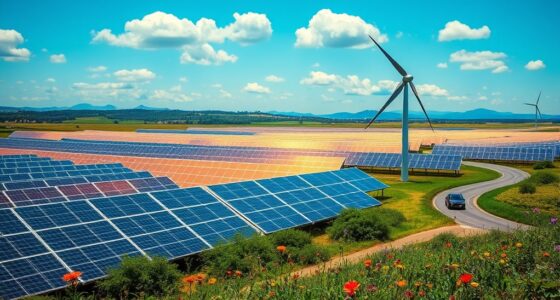Renewable energy includes five main sources, such as solar, wind, hydro, geothermal, and tidal power. Geothermal harnesses Earth’s heat for reliable electricity, while tidal captures ocean movements driven by the moon for clean, predictable energy. Both rely on natural forces and provide steady power that isn’t affected by weather or time. If you want to understand how these unique sources contribute to a sustainable future, keep exploring these innovative solutions further.
Key Takeaways
- The Big 5 renewable energy sources include solar, wind, hydro, geothermal, and tidal energy, each harnessing natural forces for power.
- Geothermal energy utilizes heat from beneath Earth’s surface for reliable electricity and heating, unaffected by weather.
- Tidal energy captures ocean tide movements, providing predictable, low-impact electricity from gravitational pull of the moon and sun.
- Advances in energy storage technologies enhance integration of consistent sources like geothermal and tidal into power grids.
- Expanding these natural resource-based energies helps diversify the renewable portfolio, reducing reliance on fossil fuels and lowering emissions.

Renewable power sources are essential for creating a sustainable energy future. They help reduce reliance on fossil fuels, lower greenhouse gas emissions, and promote a healthier planet. Among the various options, geothermal energy and tidal energy stand out because of their unique capabilities and potential. Geothermal potential refers to harnessing heat from beneath the Earth’s surface to generate electricity or provide direct heating. It’s a reliable, consistent source because the Earth’s heat isn’t affected by weather or time of day. If you’re exploring sustainable options, geothermal energy offers a steady supply that can operate 24/7, making it highly dependable compared to intermittent sources like solar and wind. Countries with active volcanic regions or significant geothermal activity have already tapped into this potential, creating power plants that produce clean energy with minimal environmental impact. You might consider geothermal energy as a pivotal part of your future energy mix, especially if you live in regions with high geothermal potential. Additionally, advancements in energy storage technologies are making it easier to integrate these consistent renewable sources into existing power grids, ensuring reliable supply even when demand fluctuates.
Tidal energy, on the other hand, harnesses the power of ocean tides to generate electricity. This form of energy capitalizes on the gravitational pull of the moon and the sun, creating regular, predictable movements in the ocean. Tidal energy is remarkably consistent because tides follow a natural lunar cycle, unlike wind or sunlight, which can be unpredictable. If you’re interested in renewable energy sources that provide stability, tidal energy offers a compelling choice. It’s especially suitable for coastal regions where fast-moving tides can be captured efficiently using tidal barrages or turbines placed underwater. Although tidal energy is still in the developmental stage compared to other renewable sources, its high predictability and low ecological impact make it an attractive option for future energy systems. As technology advances and costs decrease, tidal power could become a more widespread component of sustainable energy portfolios.
Both geothermal potential and tidal energy demonstrate how harnessing natural forces can deliver clean, reliable power. They remind you that renewable energy isn’t just about solar panels or wind turbines — it’s about tapping into diverse natural resources that can provide steady, eco-friendly power. While each has its unique challenges, they also hold significant promise for expanding the clean energy landscape. If you’re committed to reducing your carbon footprint and supporting a sustainable future, understanding and investing in these lesser-known but potent energy sources could play a fundamental role. As technology progresses and awareness grows, geothermal and tidal energy could become cornerstones of a resilient, low-impact energy system for generations to come.
Frequently Asked Questions
How Do Renewable Energy Storage Systems Work?
Renewable energy storage systems work by capturing excess power, often using advanced battery technology, so you can use it later. When your renewable sources like solar or wind produce more energy than needed, the system stores it in batteries. During low production or high demand, the stored energy helps with grid integration, ensuring a steady power supply. This makes your renewable energy more reliable and efficient around the clock.
What Are the Environmental Impacts of Each Renewable Source?
You should know that each renewable source has unique environmental footprints and ecosystem effects. Wind turbines can impact bird and bat populations, while solar farms may alter land use and local habitats. Hydropower can disrupt aquatic ecosystems, and bioenergy might lead to deforestation. Geothermal energy has minimal footprints but can cause land subsidence. Understanding these impacts helps you make informed decisions about sustainable energy choices.
How Cost-Effective Are Renewable Energy Options Long-Term?
Did you know that solar and wind energy have seen cost reductions of over 80% in the past decade? This makes renewable options highly cost-effective long-term. When you perform a cost benefit analysis, these sources often outperform fossil fuels. Plus, many governments offer financial incentives like tax credits and subsidies, further boosting affordability. Over time, renewables save you money on energy bills while helping the environment.
What Innovations Are Emerging in Renewable Energy Technology?
You’re curious about emerging innovations in renewable energy technology. You’ll see significant progress in solar panel advancements, making them more efficient and affordable. Tidal energy innovations are also gaining momentum, harnessing ocean currents more effectively. These breakthroughs mean cleaner, cheaper power for you and a step closer to a sustainable future. Staying informed about these innovations helps you understand how renewable energy transforms from potential to reality.
How Can Individuals Contribute to Renewable Energy Adoption?
Did you know that individual actions can markedly boost renewable energy adoption? You can contribute by engaging in community involvement, such as supporting local renewable projects or joining clean energy groups. Additionally, advocating for policy changes encourages governments and businesses to prioritize renewables. Your voice matters—by staying informed and pushing for sustainable policies, you help accelerate the shift to a cleaner, greener future for everyone.
Conclusion
Now that you know the big five renewable power sources, you might think switching is complicated or costly. But the truth is, embracing clean energy is more accessible than ever, and it’s a smart move for your future. Don’t let doubts hold you back—every step toward renewables helps reduce pollution and saves money in the long run. So, why not start exploring your options today? Change isn’t as hard as you might think—and it’s worth it.









